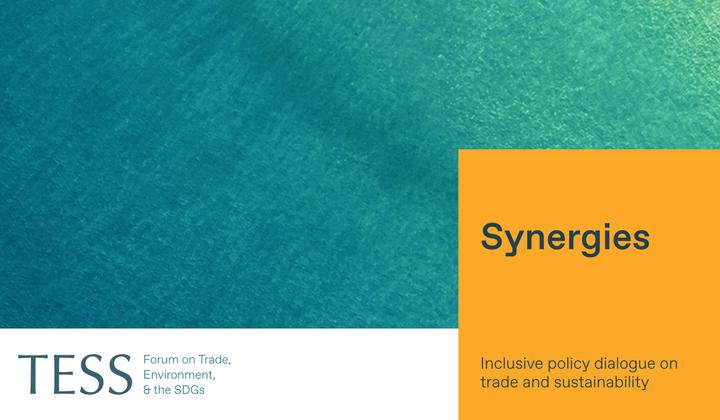This article argues that the gap between developed and developing countries in the development, access, and endogenous production and deployment of climate technologies is a key constraint on collective progress in global efforts to achieve sustainable development and effective climate action under the UNFCCC and the Paris Agreement. The author calls for enhanced international cooperation arrangements in the WTO, the UNFCCC, and elsewhere to foster effective technology transfer for climate action.
Disclaimer
Any views and opinions expressed on Synergies are those of the author(s) and do not necessarily reflect those of TESS or any of its partner organizations or funders.
-----
The multiplicity of intersecting global economic, social, political, and environmental challenges are undermining hard-won development gains and hampering progress towards achievement of the Sustainable Development Goals by 2030. Developing countries confront the dilemma of having to pursue sustainable economic development while keeping emissions and resource consumption within ecological boundaries, while in most cases being in a position of structural and institutional weakness. Among these challenges, climate change is a systemic and existential threat.
To hold global warming to between 1.5 and 2.0 degrees Celsius as stipulated in the Paris Agreement, energy and productive sectors must undertake a rapid and systemic transformation towards low-carbon pathways. Most of the necessary emissions reductions can be achieved by deploying and expanding the use of existing, commercially proven low-carbon technologies. Developing countries also need technologies to put their economies on climate change-adapted pathways and to address climate change-related losses and damage.
Many developing countries have struggled to move through these channels from simple foreign technology acquisition into adaptation and subsequent endogenous technology development.
However, despite the possibility of accessing and acquiring technologies through the usual channels—such as trade, foreign direct investment, licensing, or movements of people—and then innovating and adapting such technologies, many developing countries have struggled to move through these channels from simple foreign technology acquisition into adaptation and subsequent endogenous technology development.
These barriers—which may vary according to specific sectoral and country contexts and can range from insufficient human capabilities to economic constraints like access to capital, institutional limitations such as inadequate legal protections, or a lack of understanding of local needs for example—have created a wide technology gap between developed countries and the large majority of developing countries, in many cases reflecting a broader development gap. This gap is among the key constraints adversely affecting collective progress in global efforts to achieve sustainable development and effective climate action under the UNFCCC and its Paris Agreement.
Technology Transfer as a Key Means to Address the Technology Gap in Climate Action
Developing countries view technology transfer as a key way to reduce technological, knowledge, and capacity gaps, as well as income and wealth gaps between developed and developing countries, particularly in regard to climate action. Technology development and transfer as a means of implementation and climate action is clearly highlighted in Article 4.7 of the United Nations Framework Convention on Climate Change (UNFCCC) and Articles 10.5 and 10.6 of the Paris Agreement. Many developing countries have also indicated the importance of technological innovation, research and development, and technology transfer in their nationally determined contributions under the Paris Agreement.
As most technologies that developing countries import, absorb, or adapt are privately owned, and most climate-relevant technologies are developed and produced in and traded by developed countries (with China being the major outlier among developing countries as a producer and trader of such technologies), the main direction of, and enhanced efforts for, technology transfer will have to be from developed to developing countries, although South-South cooperation will also have an important role to play.
Due to the diversity of countries’ national circumstances and innovation needs, there is no one-size-fits-all approach to technology transfer.
Due to the diversity of countries’ national circumstances and innovation needs, there is no one-size-fits-all approach to technology transfer. To be effective, however, it should include not only the physical hardware but also the technical know-how and capabilities necessary to understand, operate, and maintain new technologies, as well as institutional and policy arrangements that facilitate technological uptake and encourage local innovation. To be sustainable, technology transfer requires the capabilities to deploy, operate, maintain, adapt, improve, and reproduce the transferred technology and, ultimately, the capacity to invent new technologies.
There are specific treaty provisions pertaining to technology transfer to support climate change action under the UNFCCC and its Paris Agreement. Institutions such as the Technology Mechanism have also been set up under the convention. Developing countries have undertaken technology needs assessments and developed technology action plans under the UNFCCC.
Through these, developing countries have identified their technology transfer priorities in the mitigation and adaptation sectors, largely in relation to energy, transport, agriculture, water, and infrastructure and settlements. They have also identified the barriers to technology transfer that they experience as well as the enablers that would be needed to support effective technology transfer, such as financing for technology transfer.
The Role of International Trade Measures
When pursued in conjunction with other policy measures designed to increase endogenous technological uptake and innovation, international trade measures have the potential to support the diffusion of climate-relevant technologies, increasing their availability, access, and potential to be used by developing countries to undertake climate mitigation, adapt to the impacts of climate change, and build resilience. The impact on innovation is less clear.
When pursued in conjunction with other policy measures designed to increase endogenous technological uptake and innovation, international trade measures have the potential to support the diffusion of climate-relevant technologies...
By themselves, however, such trade measures might not decrease the technological gap between developed and developing countries, with most production and trade of such goods being dominated largely by developed countries. In this context, trade in climate-relevant goods, services, and technologies should be complemented by other supportive domestic policy measures intended to increase the ability of the importing country’s economic sectors to absorb such technology, innovate and adapt it to domestic requirements, and develop endogenous climate technologies.
Attention should also be paid to ensuring that national intellectual property systems are geared towards promoting and supporting endogenous learning and follow-on innovation with respect to domestically generated as well as imported and transferred technologies, with due consideration “to selecting [intellectual property] standards that recognize the rights of inventors but encourage dynamic competition.” Strategic use of intellectual property flexibilities available under the World Trade Organization (WTO) Agreement on Trade-Related Aspects of Intellectual Property Rights should be explored.
Enhanced International Cooperation as Critical to Effective Technology Transfer
National action and international cooperation are critical to promote the transfer of technology from developed to developing countries to support effective climate action and to encourage the development of endogenous technologies in developing countries.
There are three key areas in which complementary domestic and international cooperation efforts need to be made in this regard: facilitating technology transfers of climate-relevant technologies from developed to developing countries; providing additional finance for developing countries; and building their capacities to address climate challenges facing their tradeable sectors.
At the national level, a more strategic approach to technology-related policymaking in the context of the achievement of national sustainable development priorities and objectives will be necessary, with structural transformation of the national economy as the goal. A key tool in this regard would be the employment and use of green industrial policy as an important part of the policy mix.
At the international level, there are various entry points for boosting cooperation arrangements on technology transfer within and outside the WTO in ways that lead to development of endogenous technologies as well as self-reliance by developing countries with respect to climate technologies. Such arrangements include enhancing the work of existing fora in the WTO and in the UNFCCC with respect to the interlinkages between technology transfer, climate change obligations, sustainable development priorities, and international trade measures.
-----
Vicente Paolo Yu is an independent expert and consultant for various United Nations agencies and NGOs.
This article is drawn from a forthcoming TESS policy brief on Addressing the climate technology gap through effective technology transfer by Vicente Paolo Yu.
-----
Synergies by TESS is a blog dedicated to promoting inclusive policy dialogue at the intersection of trade, environment, and sustainable development, drawing on perspectives from a range of experts from around the globe. The editor is Fabrice Lehmann.
Disclaimer
Any views and opinions expressed on Synergies are those of the author(s) and do not necessarily reflect those of TESS or any of its partner organizations or funders.
License
All of the content on Synergies is licensed under a Creative Commons Attribution-NonCommercial-ShareAlike 4.0 International (CC BY-NC-SA 4.0)
license. This means you are welcome to adapt, copy, and share it on your platforms with attribution to the source and author(s), but not for commercial purposes. You must also share it under the same CC BY-NC-SA 4.0 license.
If you would like to reuse any material published here or if you have any other question related to Synergies, send an email to fabrice.lehmann@graduateinstitute.ch.



